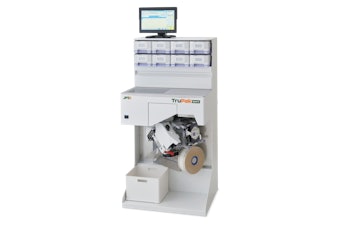At the WERC annual conference yesterday, Kenco Group representatives Kristi Montgomery, VP of Innovation, David Caines, Chief Operating Officer, Dan Coll, VP of E-commerce Fulfillment, and Chris Hess, Director of Supply Chain Solutions, discussed how to find balance and accommodate B2C market demands. Kenco Group is a woman-owned, full-service third-party logistics company that has been in business 71 years and has $800 million in revenue. This conversation has been edited for length.
E-commerce Growth
Kristi Montgomery:
I'll start with you, David. What have we seen in the last 18 months as it relates to e-commerce growth and how are our B2B shippers tackling that challenge?
David Caines:
It depends on what source you're looking at, but obviously several years were pulled ahead in terms of e-commerce last year. Forty-four percent growth is the number that we see from 2019 into 2020, and as it's sitting now 22% - 23% of retail spend is happening digitally through e-commerce. So, it's pretty incredible and any B2B shipper that didn't have their focus on that obviously was shaken up in 2020 and had to turn their attention.
I think part of the trick for some of the B2B is when they don't control a full basket of goods - figuring out how they'd partner with different aggregators to really bring forth a viable solution that includes their products and their brands and their logos. Then of course on everyone's mind when you bring up the word e-commerce is Amazon, and I think what people struggle with there is competing with the uncompetitive. Amazon's logistics cost as a percentage of their net sales depending on what source you look at is 26% - 28%. That's not sustainable or competitive but it doesn't seem imminent for them to cut that back right now.
Key Learnings for Those New to E-commerce
Kristi Montgomery:
Dan, what would you say is one of the key learnings that traditional shippers are often caught off guard by, when they step into this e-commerce world?
Dan Coll:
I think the biggest shock to the system is the difference between the customer experience or customer expectations. From an expectation standpoint, the constant communication of “I received the order, the order is shipped, details of when it's going to be delivered.” So, it's not just pushing information, but it's continuous information on status, which requires a different way of thinking from a technology stack perspective. Customers expect that when they place an order it's obviously going to be processed and en route the same day, unlike getting a B2B PO and having 48 hours or 72 hours to get the order prepped and ready to ship. It's all about time in transit. Once it leaves the facility to the time it gets to the customer door - whether someone is trying to compete with an Amazon Prime-like service and have a same day, next day, or two day, or they have a strategy where they commit to having the order delivered in several days.
Facing Customer Expectations
Kristi Montgomery:
Do you have any tips or tricks to offer B2B shippers as they're stepping into this space to face that customer expectation requirement?
Dan Coll:
In relation to transportation on the B2B side, for LTL and full truckload, we have hundreds of options and that's not really the case in parcel. There's less providers but there's niche solutions, and really understanding if you could take advantage of those niche solutions is really important.
I break the small parcel transportation space into four buckets. You have the duopoly with FedEx and UPS, you have USPS, you have postal consolidators like Pitney Bowes and DHL e-commerce, and then you have regional carriers, for example OnTrac, that serves Western U.S. and LaserShip, that serves Eastern U.S. Then there are a bunch of smaller providers in there.
I think when you're looking at this space, whether you're in it or just starting to embark on it, is really getting strategic ...understanding your transportation data, having conversations with the carriers that are a good fit for you, and what's really important and critical for this year is every one of these carriers right now is asking for your forecast. When is your peak forecast, what's your volume going to look like in November and December, and it's basically coming down to what carrier can you use for what percent of your volume? So having a multi-carrier strategy is really going to be critical as we enter into the 2021 peak season.
David Caines:
There's some data, to put behind what Dan's talking about. UPS and FedEx - and I'll lump DHL in there even though they're an aggregator, those three, their market cap grew $110 billion in 2020. So, their ability to really control that market, pick and choose what they want, find the most attractive freight that works for their network. The ability to start to find some of those other solutions if you can't get everything you need out of the two giants is going to be really, really critical to success.
Solutions for the Traditional Warehouse
Kristi Montgomery:
That's a great point, David. Chris, as you are designing solutions for bringing e-comm into a traditional warehouse, what's the major hurdles that you feel like operations faces?
Chris Hess:
I think that breaks down into three main areas. The first is WMS capability. As you look at your WMS and you think about how it serves a B2B customer, let's think about taking what would be hundreds of orders a day and making them thousands or tens of thousands of orders a day, going through a building, and then think about how you train your people and those type of things. WMS really needs to direct traffic and also be able to walk an associate through the process versus having to learn that process.
Within that is also tracking and manifesting capabilities. As we heard carriers are limited. The ability to pack in the smallest weight dimensioned container possible is critical and then being able to get that and provide the information needed to those big three carriers in the way they need it is also important.
Also within the WMS is returns processing, and it's something that a lot of folks don't think about. As a B2B to you handle returns in a pallet level or a case level but now you have to think about receiving something at each level and doing grading processes on it to figure out how you want to disposition that article; if it's a return to stock, if it needs to be refurbished, or if it needs to be sold on a secondary market or disposed of. So, lots of different variations there in the returns process that aren't typical in a B2B area.
The next point is labor. I think we're all feeling the labor pinch right now but the labor for e-commerce is very different than the labor for B2B. You need to think about not only the seasonal peaks that David talked about, November, December, but you need to think about the weekly peaks of Monday and Tuesday coming out of a weekend. Those all demand that you think about a much more flexible workforce than what you have in B2B where the buying is pretty spread out and you have some more time to be able to spread that workload. Here, with windows that you need to ship same day that you receive the order for, anything that you get before ‘x’ time in the afternoon puts challenges on the system.
The third of the big three is space and equipment. Traditionally each opp has fairly poor utilization in a warehouse, so unless you go up into mezzanine for some of those things you're spread out and the areas to receive, especially if you're receiving a niche level, is a lot bigger than if you are receiving at pallet or case level.
Similarly with picking, because a lot of the picking is done by hand at a unit level for e-commerce.
The third part is that space for returns that I talked about earlier also drives a lot more footprint in a warehouse that typically doesn't exist.
All of the stations that you need for those receiving tables, for packing tables, and those types of things take a bunch of room as well. So, those are the big three things that you need to think about.
Technical Needs
Kristi Montgomery:
Chris, what are the upstream and downstream items that come into play on the technical-needs side of things, and what's the broader impact on the organization?
Chris Hess:
You really need to get that OMS in place and build your one-time integrated WMS and let the OMS do the work, whether it's connecting to Shopify or any of the other shopping carts, or directly from a customer that's sending you APIs or emails, or the many different channels that they can get orders to you.
On the back-end side I think you also need to think about tools. Labor management. As alluded to before, being able to train your team is important, but also being able to track their process. See how many picks an hour that they're doing. See how many orders an hour they're packing. It's critical to be able to provide the coaching that they need to make sure that everybody's successful in this endeavor and so that also ties into metrics for how many orders you have in, how many orders you have in process, how many orders shipped today, how many you have left to do before the next pool time. So that information availability and not only available to the management but to the team members on the floor so that they can have a direct idea of what's going on, what needs to be done and what needs to be accomplished by ‘x’ time.
Another part I would add is thinking about your maintenance teams and systems around the maintenance teams. Automation and IT hardware or PCs, scanners, scales, and printers; before if one went down you could go to the next one, but if you're at a packing station and a printer is down for a half hour, you lose that capacity in the printing station, the person is idle so having onsite tech teams that can address those issues very quickly is what's going to keep you to be able to be successful in this new environment.
The last part around connecting to a parcel system. Whether it be ProShip or somebody like ProShip, to be able to rate-shop the most cost-effective carrier and service that specific package needs to get to its customer is going to help differentiate you in the marketplace or at least get you to the minimum bar in the marketplace to be able to ship efficiently, because the cost of actually shipping that e-commerce parcel is probably going to be two to three times what your cost is to fill the order in your warehouse.
Labor Constraint Strategies
Kristi Montgomery:
David, we all know the market right now with space and with labor constraints, so how can distribution centers adapt to this in an agile and flexible manner? What are some strategies that we can implement?
David Caines:
I would say obviously there's just a bunch of different approaches to automation and mechanization and robotics that are out there today, and the challenge is being able to find the solution that matches the profile of your business.
There's so much technology out there, but only one or two maybe make sense for the profile of your business, or your skew setup for your volume, for fractional physical dimensions of your product, and so being able to get in there and find out what's going to make the most sense. I think the exciting thing is the cost is coming down. The technology is getting better. The ROIs are getting shorter and that's why you're starting to see this huge ramp for all of this.
Handling Returns
Kristi Montgomery:
Dan, talk a little bit about this concept of returns and how big it impacts a traditional B2B shipper when they're not ready for this, and how can they be successful here?
Dan Coll:
Approximately 30% of all products ordered online are returned. Now that varies wildly based on the category with apparel being the highest segment, and you compare that 30% to brick-and-mortar return rate which averages right around 7 or 8%. So again, a really, really massive swing there that requires a lot of strategic planning to get right. Not only because of the high impact it has operationally but customers expect fast processing to get charges reversed on their credit card, or replacement products shipped out to them. You can't just let returns stockpile in the dimly lit corner of the warehouse hoping they'll go away. The impact is so high that there's really got to be a really strong focus on it, and I really encourage everyone to start embracing returns management with the same energy level as getting orders out the door and processing live orders.
I'm starting to see some really powerful upstream technology that's focused on handling returns that can be implemented with common and pretty standard WMSs out in the space. We're starting to see some cool tech that focuses on dispositioning and making routing decisions on where products should be shipped at the time it's being returned online.
An example: If you buy a pair of shoes online and after wearing them for a few days, you discover they don't fit right. You go back online where you purchase them and you start the return process, and because the system is asking questions, it's determining that this is not a product that is going to come back pristine, that's not going to be able to be put back into stock, so it's making business rule that this product needs a trip to my liquidation arm. Let's push this product right to the secondary market because I wouldn't cut my labor costs, I don't want to pay multiple transportation for a product that I can't sell again as Grade A product.
So, I think you're going to start to see a lot more evolution in the reverse space and certainly it's going to be all about “how do you trim out transportation, how do you not have facilities ingested with returns and cutting down the labor to processing?” I think there's a lot of exciting things coming that are involving some of the return problems we're facing.























